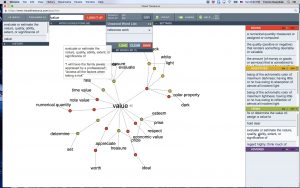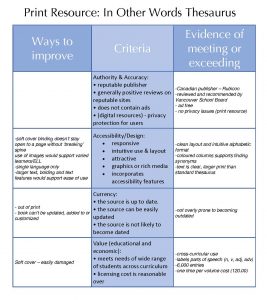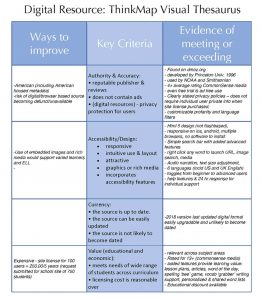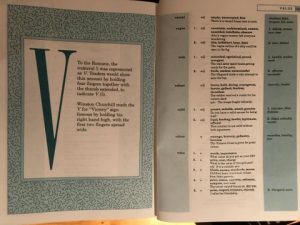Introduction
For the purposes of Assignment One, the Evaluation of a Reference Resource, I paid a visit to my ‘local’ library: the Neville Scarfe Education Library at UBC. Prior to this course, I hadn’t considered ‘reference resources’ as unique from other resources and so paid a visit to the Reference desk in the library. The reference librarian was out, so I asked the library technician to point me to the Reference Section. She informed me that, while many libraries house such a section, our library is not organized in that way. She wasn’t sure quite how we would search for references in the catalogue other than by specific type so that is what we did. On my journey through the library, I came across many dusty tombs in the stacks including multiple thesauri and more than a dozen shelves full of dictionaries, including slang dictionaries that Riedling (2013) suggests may have value depending on the school and community context (p. 66). Many of these would not meet the “MUSTIE” test (Crew, 2008, p. 46) With the library closing soon, I selected a few of the lighter volumes to bring home for review.
While Riedling (2013) responds “You bet!” (p. 61) to her own question “Do dictionaries and encyclopedias still matter today?”, I wonder. As one who subscribes to a descriptive philosophy in that I believe language is ever evolving and that dictionaries need to reflect these changes, I think such ready reference resources are best housed in an environment that allows for such change to occur as needed. Simply adding to the many volumes on multiple shelves in a library is not the most effective or efficient way to ‘update’. Instead, access to online resources is a better option as they can be updated as needed, provide access to rich media to increase engagement and learning value and, finally, are a more environmentally responsible option given the need to replace volumes periodically. While needing less frequent replacement than encyclopedia (Riedling, 2013), they do become worn and dated when they lack words commonly appearing in news reports (Crew, 2008).
A thesaurus, “a specialized dictionary that deals solely with word synonyms and antonyms” (Riedling, 2013, p. 66) holds appeal to me as a lover of language. I have my own copy of Roget’s Thesaurus and, while I have never felt it was out of date, I realize I rarely use it. Instead, I’ve come to prefer the thesaurus function in my word processor and, for teaching purposes, a much more visually appealing, rapid search tool available online: ThinkMap.
Original Library Resource: Print Thesaurus
In Other Words: An Introductory ThesaurusVera Dobson Gould & Patricia J. HughesRubicon Publishing, Toronto Canada 1991ISBN0-921156-11-1
|
The original resource is a print Thesaurus developed specifically for a middle school to high school audience. While located on the bottom shelf in a basement section of the library stacks with multiple dictionaries and thesaurus, it stands out due to the colourful binding with block lettered title. Being a soft cover resource, it is lighter in weight than other dictionaries, still, circulation records indicate it has not been checked out in the past year. Dictionaries and thesaurus account for more than a dozen shelves in the education library stacks (over a hundred volumes). Extensive weeding is needed. Circulation records indicate “In other Words” has not been checked out in the past three years, making it a candidate for weeding by Crew’s (2008) standards. A brief discussion with the reference librarian and a library technician indicated that encyclopedias, dictionaries and thesaurus are rarely borrowed and, while records do not exist for their use as reference inside the bricks and mortar library, the library technician indicated she rarely finds them in the book bins for re-shelving.
Potential Replacement: A Digital Thesaurus
ThinkMap Visual ThesaurusMultiple vetted and credentialed authors (editors, educators, academics)Copyright ThinkMap, Inc. 1998-2018 (formerly WordNet 1.7 Copyright 1996 Princeton University)LINK: http://www.thinkmap.com/ “Image from the Visual Thesaurus, Copyright ©1998-2018 Thinkmap, Inc. All rights reserved |
There are many online thesauri including ones published by such reputable and known companies as Mirriam Webster and Collins. Collins has a free subscription geared to students with a ‘primary’ and a ‘secondary’ version that contain some education related advertisements that do not interfere with usability. It is unfortunate that there does not seem to be a paid option that removes all advertisements. If such a version were available, I would recommend Collins given the responsive user interface over Mirriam Webster. While the Collins thesaurus is not as interactive and attractive as the ThinkMap Visual Thesaurus, it is quite usable, includes language translation and a word game. ThinkMap is a highly interactive, responsive and accessible visual thesaurus (see features in the evaluation rubric below).
Evaluation Rubrics
Below are two completed Single Point Rubrics with evaluative comments in italics. The rubric formatting is adapted from #singlepointrubric on Twitter for more on these more flexible, open rubrics, visit A Cult of Pedagogy.
Thesaurus rubric |
Thinkmap rubric |
Recommendations
I strongly recommend the purchase of an online thesaurus. Given the large amount of space taken up by both print thesaurus and dictionaries, their lack of use and their lack of value relative (as seen in the rubrics above) to a rich media enabled online source that includes fully functional accessibility features including multiple languages, font size adjustments, customization, a digital option is preferable.
I think one unique way to access a thesaurus in our library that would likely increase use and awareness of the value of a thesaurus, would be to install several wall-mounted touch screens including one near the reference desk and near the student work tables. On these screens, students could access the dictionary and thesaurus without the need to sit down at a work station or login. Such a resource launched and accessible would support students utilizing a thesaurus in order to improve their vocabulary and written work and would likely lead to richer vocabulary being used by library patrons in their work (and, perhaps, everyday communication!).
Given the budget available in a large academic library and the potential impact of a resource as valuable as an interactive thesaurus, I would recommend the purchase of a subscription to ThinkMap should it be possible to either negotiate a single or multi-station access license to support a digital display as mentioned above or, perhaps, university-wide option available with campus-wide login. Such access would not be unusual given the fact that UBC has licensing agreements with many proprietary cloud and computer based softwares for use by faculty, staff and students. (I am awaiting a response from the sales department to confirm exact pricing and potential plans)
References
Riedling, A. M., Houston, C., & Shake, L. (2013). Reference skills for the school librarian tools and tips. Santa Barbara, California: Linworth.

 Follow
Follow
Wow! So thorough! Thanks for such an interesting post; as is becoming the norm I’m learning so much from my colleagues and fellow students in this course. Shame about the lovely book Thesaurus but I thank you for the online visual thesaurus information and the additional rubric post. At my high school we must use rubrics specifically designed for our subject area in the IB program (Middle Years Program or MYP for grades 8, 9 and 10) based on 4 criterion although we can alter them to some extent but it’s tricky and time consuming. Glad I found your blog.
Hi Grace, glad you found me! The single point rubric is something that’s gaining traction for sure. Hopefully IB will ‘catch up’ ;D cheers and thanks!